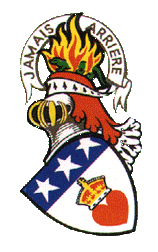Professor Robert Langton Douglas
Robert Langton Douglas (1864-1951), known professionally as R.
Langton Douglas, was a well-known British art critic, lecturer, and
author, and director of the National Gallery of Ireland.
Douglas was born in Davenham, Cheshire, England(1), and educated at New
College, Oxford. He was for years a University Extension lecturer,
and for a time was in holy orders in the Church of England. From
1895 to 1900 he resided in Italy. While a chaplain there, he wrote a
monograph on Fra Angelico in consultation with various scholars,
including Bernard Berenson. He relinquished his church appointment
in 1900 to become professor of Modern History at the University of
Adelaide, Australia, then returned to Italy in 1901 where he wrote A
History of Siena.
He lectured on art at the Royal Institution
and the Society of Arts, was made dean of the faculty of arts in
1901, and contributed to many magazines and reviews. At age 50, in
1914, Douglas enlisted in the British Army for World War I, and rose
from private to staff captain and a position with the War Office in
London. Douglas was awarded for his bravery in WWI. In 1916 Douglas
was appointed director of the National Gallery of Ireland in Dublin,
but resigned in 1923 after a disagreement with its trustees. He
settled in New York City in 1940, writing text for the Duveen art
galleries.
Known chiefly as an authority on Sienese art, his
most important publications are an edition of Crowe and
Cavalcaselle's History of Painting in Italy (1903, et. seq.), and:
Fra Angelico (second edition, 1902)
History of Siena (1902)
La Maioliche di Siena (1904)
Illustrated Catalogue of
Pictures of Siena and Objects of Art (Burlington Fine Arts Club,
1904)
A descendant of Major
James Douglas of Jamaica, himself the son of Sir Archibald Douglas
'who lived at Dornock', and was probably the son of the 1st Earl of
Queensberry, Robert Langton Douglas was the son Reverend Robert
Douglas, sometime vicar in Sheffield, and Annie Johnson.
| Sons of Robert
and Margaret Cannon |
 |
Memorial stone in Laterino Municipal Cemetery, Siena.
In this land, loved by him, he wanted
eternal rest. |

He married, firstly, Margaret Jane
Cannon, daughter of Percival Henry Cannon, in 1891. He and Margaret
Jane Cannon were divorced in 1901.
He married, secondly,
Gwendolen Mary Henchman, daughter of Thomas Henchman, in 1902. He
and Gwendolen Mary Henchman were divorced in 1927.
He
married, thirdly, Jean Stewart, daughter of John Stewart, in 1928.
She was his former research assistant, and married Edward Fowles,
head of Duveen's Paris branch and later heir to Duveen's galleries.
Douglas, by his first wife, Margaret Jane Cannon, was the father of
Marshal of the Royal Air Force
William Douglas, 1st Baron Douglas of Kirtleside.
Douglas's daughter Dr. Claire, by Jean Stewart, and the half-sister of
Marshal Douglas, was the second wife of writer J.D. Salinger.
By Grace Hutchison, he had
Terence Hutchison , a
world-famous economist.
He died in 1951, in Fiesole, Italy.
Notes:
1. Some sources have his place of birth as
Lavenham, Suffolk. However, I have been informed that
his birth certificate states Davenham, Cheshire, as does his
memorial in Siena, Itlay.
.
Sources
Sources for this article include:
• "Robert L. Douglas,
British Art Expert," New York Times obituary, 16 August 1951, p. 24


